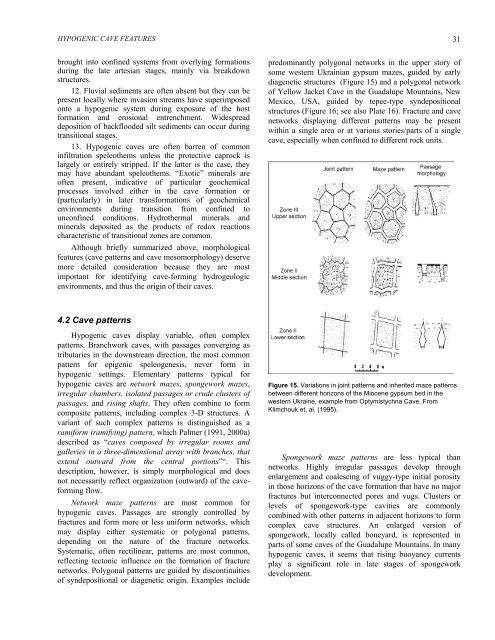Download PDF - Speleogenesis
Download PDF - Speleogenesis
Download PDF - Speleogenesis
You also want an ePaper? Increase the reach of your titles
YUMPU automatically turns print PDFs into web optimized ePapers that Google loves.
HYPOGENIC CAVE FEATURES<br />
brought into confined systems from overlying formations<br />
during the late artesian stages, mainly via breakdown<br />
structures.<br />
12. Fluvial sediments are often absent but they can be<br />
present locally where invasion streams have superimposed<br />
onto a hypogenic system during exposure of the host<br />
formation and erosional entrenchment. Widespread<br />
deposition of backflooded silt sediments can occur during<br />
transitional stages.<br />
13. Hypogenic caves are often barren of common<br />
infiltration speleothems unless the protective caprock is<br />
largely or entirely stripped. If the latter is the case, they<br />
may have abundant speleothems. “Exotic” minerals are<br />
often present, indicative of particular geochemical<br />
processes involved either in the cave formation or<br />
(particularly) in later transformations of geochemical<br />
environments during transition from confined to<br />
unconfined conditions. Hydrothermal minerals and<br />
minerals deposited as the products of redox reactions<br />
characteristic of transitional zones are common.<br />
Although briefly summarized above, morphological<br />
features (cave patterns and cave mesomorphology) deserve<br />
more detailed consideration because they are most<br />
important for identifying cave-forming hydrogeologic<br />
environments, and thus the origin of their caves.<br />
4.2 Cave patterns<br />
Hypogenic caves display variable, often complex<br />
patterns. Branchwork caves, with passages converging as<br />
tributaries in the downstream direction, the most common<br />
pattern for epigenic speleogenesis, never form in<br />
hypogenic settings. Elementary patterns typical for<br />
hypogenic caves are network mazes, spongework mazes,<br />
irregular chambers, isolated passages or crude clusters of<br />
passages, and rising shafts. They often combine to form<br />
composite patterns, including complex 3-D structures. A<br />
variant of such complex patterns is distinguished as a<br />
ramiform (ramifying) pattern, which Palmer (1991, 2000a)<br />
described as “caves composed by irregular rooms and<br />
galleries in a three-dimensional array with branches, that<br />
extend outward from the central portions”“. This<br />
description, however, is simply morphological and does<br />
not necessarily reflect organization (outward) of the caveforming<br />
flow.<br />
Network maze patterns are most common for<br />
hypogenic caves. Passages are strongly controlled by<br />
fractures and form more or less uniform networks, which<br />
may display either systematic or polygonal patterns,<br />
depending on the nature of the fracture networks.<br />
Systematic, often rectilinear, patterns are most common,<br />
reflecting tectonic influence on the formation of fracture<br />
networks. Polygonal patterns are guided by discontinuities<br />
of syndepositional or diagenetic origin. Examples include<br />
predominantly polygonal networks in the upper story of<br />
some western Ukrainian gypsum mazes, guided by early<br />
diagenetic structures (Figure 15) and a polygonal network<br />
of Yellow Jacket Cave in the Guadalupe Mountains, New<br />
Mexico, USA, guided by tepee-type syndepositional<br />
structures (Figure 16; see also Plate 16). Fracture and cave<br />
networks displaying different patterns may be present<br />
within a single area or at various stories/parts of a single<br />
cave, especially when confined to different rock units.<br />
Figure 15. Variations in joint patterns and inherited maze patterns<br />
between different horizons of the Miocene gypsum bed in the<br />
western Ukraine, example from Optymistychna Cave. From<br />
Klimchouk et. al. (1995).<br />
Spongework maze patterns are less typical than<br />
networks. Highly irregular passages develop through<br />
enlargement and coalescing of vuggy-type initial porosity<br />
in those horizons of the cave formation that have no major<br />
fractures but interconnected pores and vugs. Clusters or<br />
levels of spongework-type cavities are commonly<br />
combined with other patterns in adjacent horizons to form<br />
complex cave structures. An enlarged version of<br />
spongework, locally called boneyard, is represented in<br />
parts of some caves of the Guadalupe Mountains. In many<br />
hypogenic caves, it seems that rising buoyancy currents<br />
play a significant role in late stages of spongework<br />
development.<br />
31
















